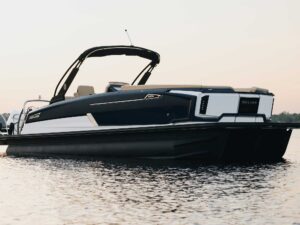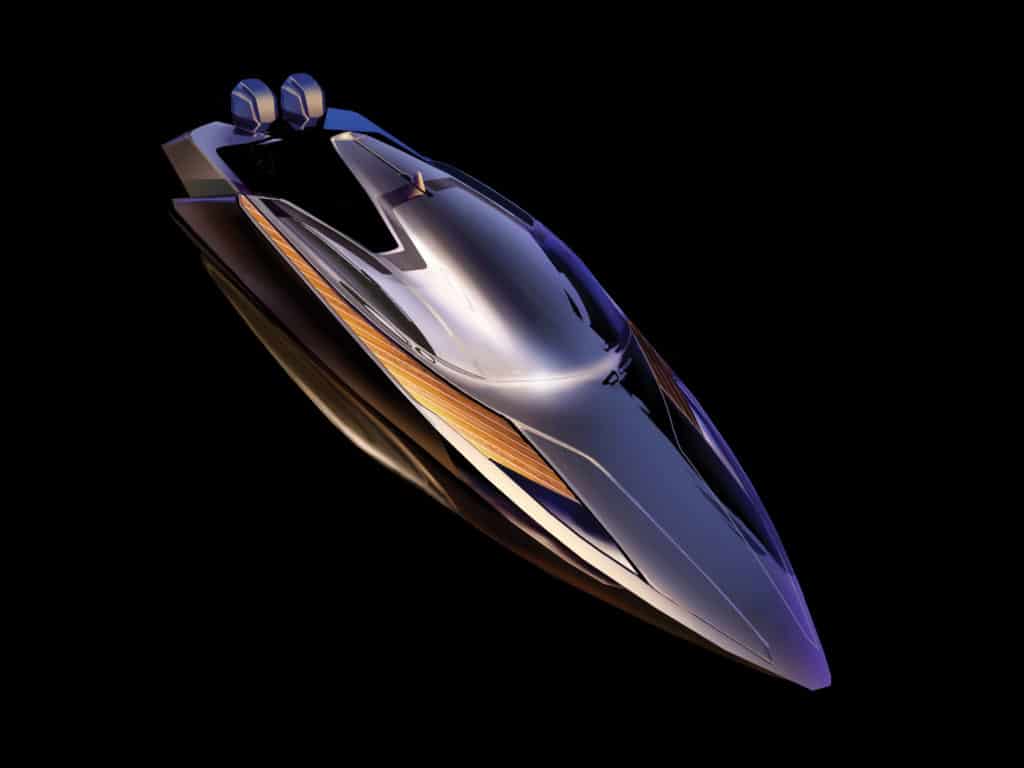
Remember when we used a telephone just to call someone? In those days, if we wanted to listen to music, take photos, plan a road trip, crunch some numbers, look at local restaurant options and do our own fact-checking, our available toolbox included a radio, camera, map, calculator, the Yellow Pages and a set of encyclopedias.
To have access to all of those things through one device, right at our fingertips? Unthinkable. Might as well turn on Star Trek reruns.
Now, of course, we can do all that and so much more. The smartphones we hold in our hands are more powerful than the Apollo 11 guidance computers, the mid-1980s Cray-2 Supercomputer, and even our fancy 21st-century laptops. They also are powerful extensions of ourselves, and we seek to have this same sense of connectedness in all of our living spaces, from our homes to our vehicles. Now we’re looking more closely at our boats. What’s next?
When we talk about the boat of the future, we imagine revolutionary hull designs, new engine configurations, clever floor plans, and even the promise of better batteries and electric power. Some contemporary yacht designers, however, believe the most exciting leap forward involves reimagining something so obvious, we just might miss it: the dashboard. In nautical-speak, it’s the helm. Get ready to level up the way you communicate with every part of your boat and how you experience your on-water lifestyle.
Pragmatic Futurism
“Technology is the purveyor of design, and it’s driving purchases these days,” says Peter Granata, owner of Granata Design based in South Carolina, and the former president of the Marine Design Resource Alliance. “It’s generational. Millennials, in particular, want to coalesce everything they need in one place and have it be almost invisible, with less for them to do. That way, the boat becomes part of their lifestyle.”
Granata is one of the marine industry’s top yacht designers. He’s produced an array of award-winning designs and patented more than a dozen ideas. This magazine named him one of the top four game-changers in marine design (boatingmag.com/game-changers).
Boats weren’t his first love, however. In the beginning, he was a car guy.
When Granata was 21 years old, he came up with a patent for a power seat that would allow the driver to push a button to readjust the seat’s position. He hired a Japanese artist to create six hand-painted brochures, and he drove to Detroit to sell his idea.
Now-defunct American Motors allowed the young innovator go through his full presentation before telling him they didn’t make power seats. Granata went on to Chrysler, General Motors and Ford. Ford bit, promising to issue a purchase order for 50,000 units, which the company rescinded a few days later.
Although his patented design didn’t make it in the Motor City, Granata says he gained a valuable lesson that has served him well ever since.
“Observation is everything,” he explains. “I loved cars, so I watched people get into their vehicles, adjust their slide seats, and use their push-button radios. Now, of course, power seats are everywhere.”
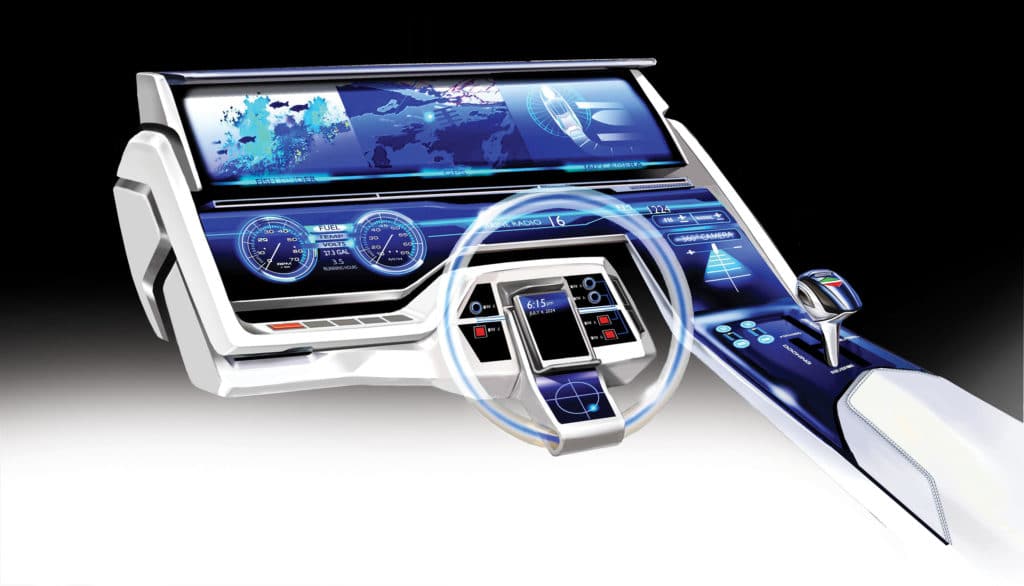
Digital Display
Intended to deliver on the promise of today’s smart devices, Granata’s billet aluminum dash features one expansive Cadillac-esque screen that incorporates all the apps. These include a GPS, fish finder, 360-degree camera, automated docking system, and marine audio system that can sync with your own music.
The automated docking system works the same way as a self-parking car. Once you pinpoint where you wish to dock, take your hands off the wheel and allow your boat to do the rest. It takes the stress out of docking just like a self-parking car eases the anxiety around parallel parking.
Another app provides gauges for fuel, temperature and volts; you can even calculate your remaining hours of fuel as you go. Analog faces offer a classic feel, but you can choose a different look as you would with an Apple Watch.
“I want people to be able to customize the dash based on how they prefer to use it,” Granata says. “But no matter how it looks, it’s still one screen that works one way.”
How will the integrated dash work with different technology producers? That’s where design innovation will meet innovation from suppliers such as Garmin, Simrad and Furuno. That might involve software, or it could mean using the Cloud, according to Granata.
“Going into the future, no one has all the answers,” he notes. “As an industry, we have to challenge ourselves. The automotive world uses supplied parts just as we do, so it behooves our suppliers to create dashboard modules that house certain information. That way, a boat manufacturer can choose what they deem necessary for a certain size boat.”
Granata’s first boat design came out in 1974, and it launched his career. What remains constant is Granata’s most important consideration: people. And that’s where the power of observation comes in.
“You have to study them, how they interact and how they want to use the boat,” he explains. “People have to come first.”
Keeping that in mind, the designer created a new dashboard that essentially serves as a user interface for a hypothetical 35-foot twin-engine cruiser. Yes, it’s a helm, but perhaps not one you have seen before—not on the water, at least.
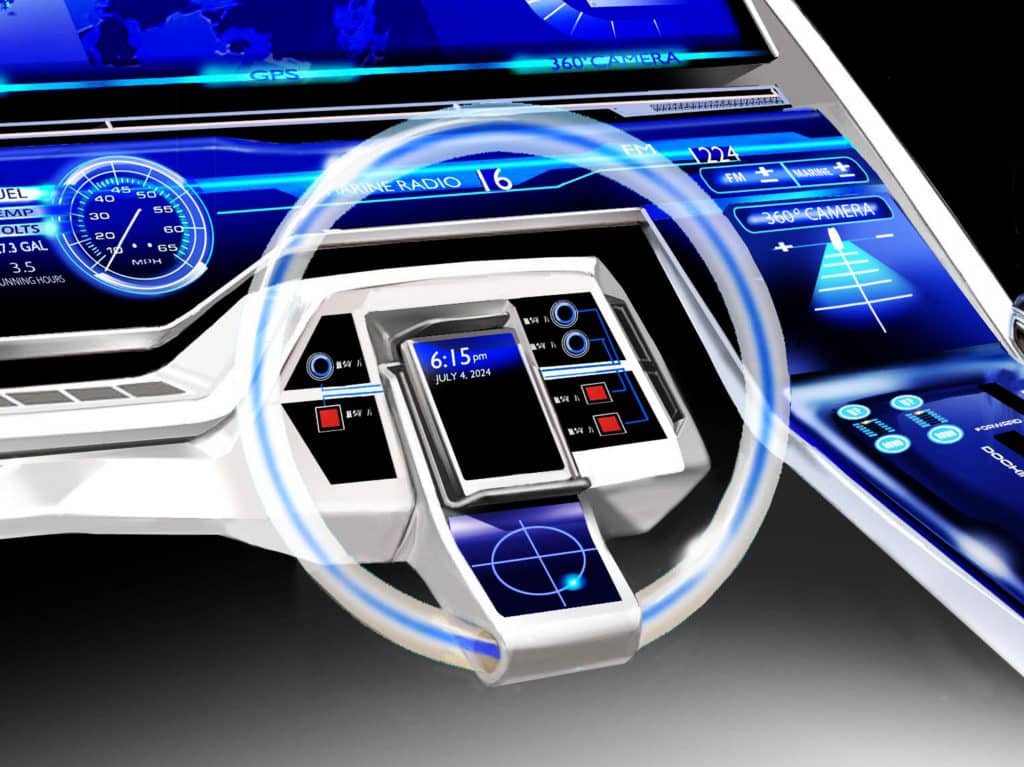
Smartphone Dock
The steering-wheel base is where you’ll find your smartphone dock, from which you can connect all your apps.
“We’re taking advantage of the technology that’s already there,” Granata says. “Your phone is your personal computer, after all.”
A footnote: Granata placed the engine start and stop switches in this space at the center of the wheel. Without spokes, you easily can reach the switches, but there’s no danger of accidentally bumping them while underway.
To be fair, boatbuilders in partnership with engine and marine electronics brands are already moving in this direction. Case in point: the Volvo Penta Glass Cockpit system developed by Garmin in collaboration with Volvo Penta for helms on Volvo-powered boats ranging from sport cruisers to motoryachts. But from Granata’s point of view, this is just the beginning.
“Right now, a boat manufacturer takes the electronics and plunks them onto a fiberglass dash,” he says. ”Different technologies are separate elements, and you have to read through multiple manuals to learn how each one works. That can be frustrating; your dash should help you, not confuse you. It needs to be more intuitive for ease of use and safety.
“The necessary technology for the dash concept already exists,” he continues. “It needs to be integrated, however, not just assembled. The automotive industry has moved into this area strongly, and they’re moving quickly.”
As a pragmatic futurist, Granata predicts this concept will provide the next leap forward for recreational boat brands. And he’s not alone.
Simplicity and Control
Jack Telnack was Ford Motor Company’s global vice president of design from 1980 to 1997. He began working with Ford as a designer in 1958 and became head stylist of Lincoln-Mercury in 1965. Telnack was inducted into the Automotive Hall of Fame in 2008.
He also worked as a designer for Trojan Yachts during its early fiberglass years, and he remains an avid boater today; he currently owns a 30-foot Chris-Craft and 28-foot Pursuit.
“The trend today is to simplify,” he says. “One screen, one format, one presentation. It’s true that the automotive industry has influenced the boating industry, but a lot of marine design has influenced automotive over the years as well. It goes both ways because people want the same features.
“When Tesla did its screen, you had to look to the center for all the functions—even the speedometer,” he says. “Lincoln did something similar. The Ford Mustang Mach-E did too, but they chose to keep the speedometer and tachometer in front of the driver. Then Cadillac came out with a large rectangular screen that stretched horizontally from in front of the driver to the center. I liked that. As the driver, I want to see everything, not one thing at a time.”

Steering Wheel
Granata drew inspiration from the Zero Bike—designed by Japanese art students Makota Makita and Hiroshi Tsuzaki more than 30 years ago in Los Angeles—for his smart dash’s sleek steering wheel. It looks otherworldly. Magnetic superconductivity makes the magic happen; the wheel doesn’t have spokes or hubs, so it depends on magnets to suspend and cradle the rim.
“An encapsulated magnetic strip on the back determines where the wheel is and coordinates with the throttle,” Granata explains. “A screen just below the wheel shows the driver its orientation. With current steering systems, you have little idea of the direction you’re aimed. This direction reader even tells you what direction you’ll be traveling if you’re in reverse.”
The acrylic (or similar material) fly-by-wire steering wheel tilts, can move forward and back, and has its own illumination. This light and the magnetic strip are both contained, protecting them from the marine environment.
“As demonstrated in the cycle using this technology for its wheels, the system can be designed to be very rugged and waterproof,” Granata says.
The wheel design provides more dashboard space than a traditional spoke steering wheel allows. Current marine dashboards already are full of electronics, and as demand grows for additional components, overcrowding is a real concern.
“The area behind a traditional spoke wheel is valuable real estate, and with boat buyers demanding larger screen sizes, every inch of that space is critical,” Granata says.
In this design, even the base of the steering wheel—right through the center, where the spokes would be—makes an important contribution.
Daniel Vieira, vice president of yacht design for Hudson Yacht Group, says he thinks this kind of full integration is the most exciting development in yacht design.
“This is the future,” he says. “We’re looking at boats holistically. More owners want everything to run through the helm, and they don’t want to have to adapt to a new interface with each piece of technology, or see the dash change as components change. We’re going to see more tech overlap—communication between components.”
Vieira earned his Bachelor of Fine Arts degree in industrial design from Savannah College of Art and Design, and his MBA from Florida International University. He worked as an industrial designer for MasterCraft for 15 years.
“I designed different dashes for MasterCraft, and in 2018, I did one that had two versions—one was all digital,” he says. “That’s definitely the trend—going all glass.”
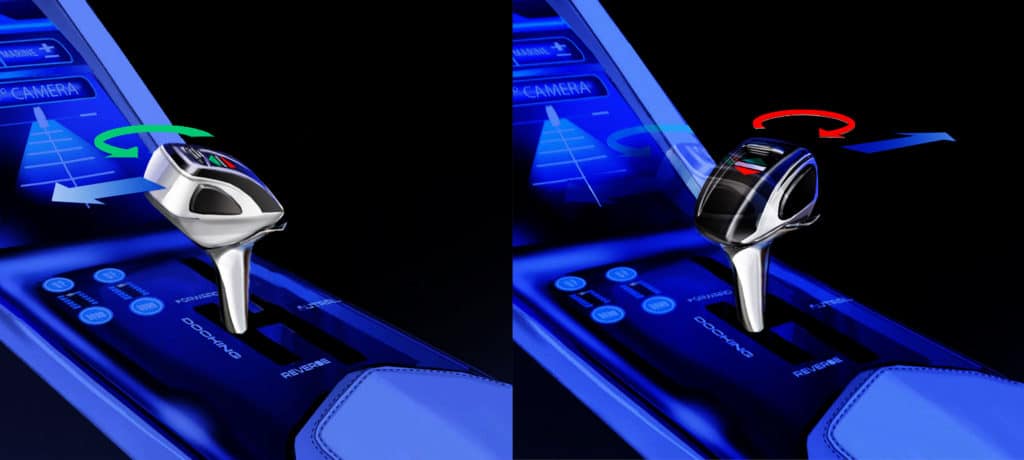
Throttle/Joystick
The smart dash’s throttle is actually a two-in-one throttle and joystick. In throttle mode, you can operate both engines in forward, neutral and reverse.
“With the joystick, there’s no need to manipulate two throttles,” Granata observes. “It’s like the floppy disk. It’s no longer necessary, so we’ve moved on.”
The throttle features lights to indicate if you’re in neutral or in motion, so you won’t find yourself racing to fend off a neighboring boat when you thought you were in neutral. A thumb lever trims both engines.
As a bonus, an automated system ensures that a shut-down engine will immediately rise from the water to avoid dragging; when you press the start button for that engine, it will lower before starting. Then it will join the trim angle set for the running engine.
To use the joystick, simply pivot the handle to the left or right. For better control, Granata designed this single handle to feel like a computer mouse.
“I kept it simple to keep it relatable,” he says. “You’ll find you have even more control than with a regular joystick.”
Vieira also served as the platform designer for Aviara Boats. The concept presented a new approach based on the latest research for a 30- to 40-foot open-bow day cruiser.
“In this market, the driver wants everything to run through him,” Vieira reflects. “It’s a point of pride. He wants to have control over every aspect of the environment so he can have control over delivering a fun experience. It’s about being a great host.”
The designer noted that these boaters are equally attentive to the quality of the lived experience in their own homes, and they want to extend that to their boats. For them, owning a boat is about the experience, not the thing itself. And if a seamless, integrated, user-friendly interface with all components in one location can deliver that experience to life on the water, they’re on board.
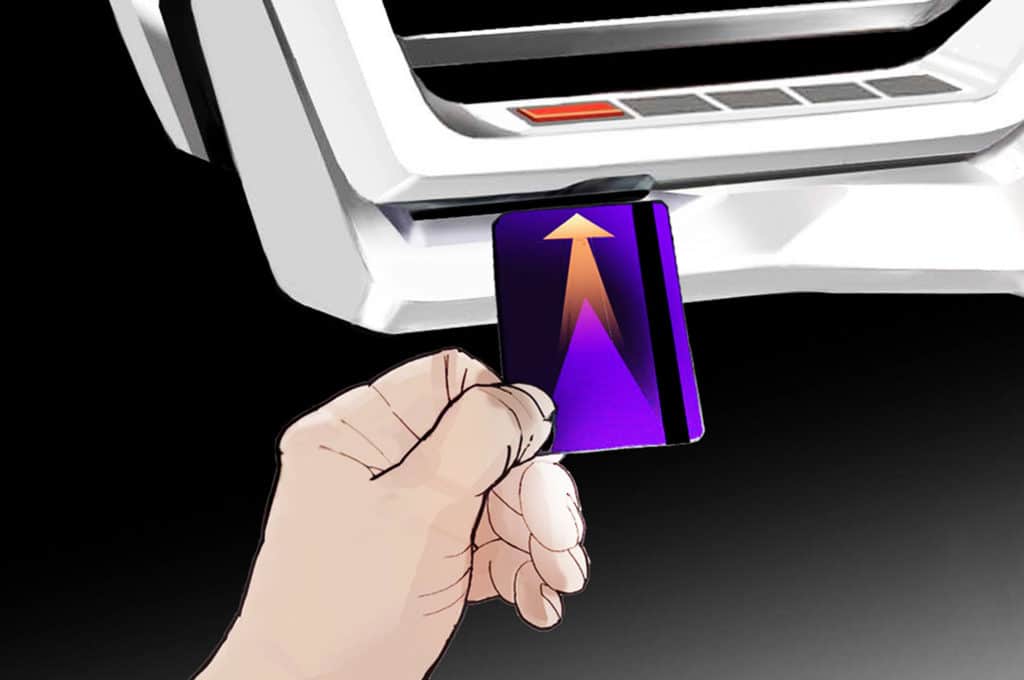
The Extras
Just above the steering wheel to the right is a long slit. This is the source of your heat and air conditioning; you’ll find the microphone here as well. With the wind buffered, this is the quietest spot on the boat.
And to the left of the wheel, you’ll find an ignition slot for a key card.
During the COVID-19 pandemic, boatbuilders have produced boats as quickly as possible. Inventories are low, waiting periods are long, and it seems just about everyone wants to buy a boat. Going into the 2021 boating season, that hasn’t changed.
It will. And when that happens, Granata says industry leaders need to be prepared for what’s next.
“If we’re so busy selling, we’re not developing, and that shrinks our future opportunities,” he says. “Historically, the boating industry has been an originator and developer of ideas. We need to get out beyond where we are now.”

